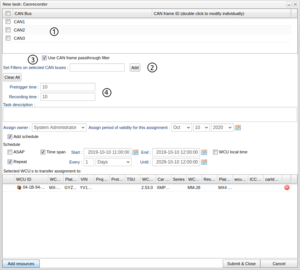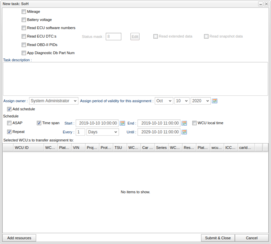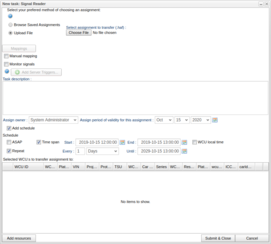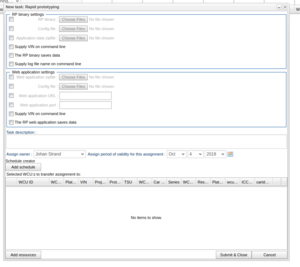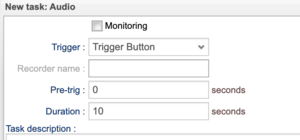Creating a Task
You create a new task by pressing the "New Task" button on the bottom of the "Tasks" tab. This will open a window where you choose the type of assignment you want to create. Here we will go through how to create tasks of each of the different kinds of assignments available (Canrecorder, IDC, SoH, Signal Reader, SWDL, Video, MQTT, ETAS, SoftHub and blue piraT).
CAN-recorder
Canrecorder is a measurement module that allows CAN frames to be captured and logged. This assignment has four options described in Figure "Canrecorder" and below:
1. In the grid, select which bus (or buses) to record from. By clicking the check box in the top left corner, you can select all buses at once.
2. Specify which CAN frames you want to record by entering their CAN IDs in the CAN frame ID column in the grid, on the same row as the bus you have selected, or by entering the IDs in the text box labeled “Set filters on selected CAN buses”. If you use the latter option, the filters will be set on all of the buses you have selected. To enter a filter on a specific bus use the method of entering the filter on the same row as the selected bus, on the grid. This can only be done if the CAN frame passthrough filter is turned on. Turning off the CAN frame passthrough filter option will disable the CAN frame ID column in the grid. Press the “Clear All” button to remove all the entered filters from all buses.
3. Turning on or off a CAN frame pass-through filter. If you choose to have the filter on you must specify which CAN bus or CAN buses you wish to record.
4. Select how long time to record before and after the trigger.
Scheduling
For WCUs with version >= 2.53 this task can be scheduled by selecting the "Add schedule"-checkbox. By doing so, the panel shown in Figure "Schedule Panel" appears. By thereafter selecting the "ASAP" checkbox, the task will be performed once and as soon as possible. If instead the task is to be performed at a specified time, deselect the "Time span" and "Repeat"-checkboxes and select the sought time in the "Start field". The task can also be performed within a certain time span, and in this case "Time span" should be checked and the Date in "End" field specified. Repetition of the task is defined by checking the "Repeat" checkbox, defining a interval size in the field after "Every" and a recurrence rate in the drop down menu. The task will then be repeated at this rate until the date defined in the "Until" field is reached.
To control the time zone in which the task scheduling is to be performed the "WCU local time"-checkbox is used. If this option is deselected, the task will be performed in UTC-time (the date fields present the portal local time). On the other hand, if this box is checked, the task will be performed according to the local time zone predefined for the WCU. A WCU time zone can be defined for a WCU with version >= 2.53 by an administrator using "Edit configuration" in the Vehicles panel. This is useful when there is a need to perform a certain task at a specific time of the day regardless of which country the vehicle is in. For instance, when selecting 100 different WCUs scheduled to perform a task at 10:00, checking the "WCU local time"-checkbox will result in them performing the task according to their time zone setting. Without checking this option, the task will be performed in the corresponding UTC-time, which could mean in the middle of the day or night depending on where the vehicle is located.
IDC
The Internal Diagnostic Client (IDC) is a measurement module that allows a sequence of diagnostic requests to be sent and responses recorded. The sequence of diagnostic requests are uploaded to the portal as a text file (usually ending with ".seq"). This task can also be scheduled in the same manner as described for the Canrecoder task.
SoH
A State of Health (SoH) assignment collects specific status information from vehicles. You select which information you want the assignment to collect by filling in one or more of the six boxes shown in Figure "SoH tab". In order for SoH data to be correctly interpreted, relevant description files (SDDB/GDS) for the vehicles executing the SoH assignment must have been defined. To add a SDDB/GDS file to a vehicle, see The Edit Car Dialog.The six different options are:
- Mileage
- Voltage
- Read ECU software numbers
- Read ECU DTC:s
- Read OBD-II PIDs
- App Diagnotstic Db Part Num
This task can also be scheduled in the same manner as described for the Canrecoder task.
Signal Reader
Signal Reader is a measurement module that allows monitoring and logging of CAN and FlexRay signals, as well as diagnostics data. To create a Signal Reader assignment you proceed as follows:
1. You either select an assignment file of .haf format, or choose an assignment created in the assignment creator. Your current choice will be displayed in the "Chosen file" field.
2. When you have selected an assignment and a WCU unit(s), the CAN buses defined in the assignment and on the WCU will be mapped. If they can be automatically mapped a green check symbol will be displayed, otherwise a red cross will be displayed. Clicking the mapping button will open the mapper. In the pop-up window you will have to map the different buses to each other manually and then save. Once this is done correctly, the red cross will become a green check, indicating that the mappings are ready to be automatically applied upon submit. Read more about this in I/O configurations and Mappings.
3. With a Signal Reader assignment you can monitor CAN, FlexRay or WCU-internal signals live by selecting "Monitor signals". When selected, two boxes will appear under the task description. In the left one you search for signals and drag them over to the right one where the signals to be monitored are listed. You can later see the monitored signals by pressing the Monitor Signals button either in the Tasks tab or in the Vehicles tab. It is also possible to copy the signals text in the bottom right corner of the right box. Next to the copy text button you can also paste signals as text where the pasted signal names will be matched against the list of unselected signals
4. You can choose if you want the signals to have their data source names as a prefix (e.g. CAN1.EngineSpeed instead of EngineSpeed).
5. The Signal Reader assignment will generate result files. It may be interesting to know if certain signals reach certain values in these result files, therefore it is possible to add Server Triggers to the assignment that will trigger and add a suitable label to the corresponding result file. Read more about this here.
Signal Reader can also act as a signal broker for other software components. Read more about this in WICE Signal Broker API. This task can also be scheduled in the same manner as described for the Canrecoder task.
Files containing references to sequence files
If the measurement file contains references to sequence files, you are also required to select these in order to run the assignment. The portal scans the .haf file for such entries and presents this to you, see illustration 4.2. Click the button for each sequence file reference to upload each sequence file needed. Some queries in the sequence file are of functional type, i.e. posed to all ECUs, and in such cases you can select the option of using Snapshots or Extended data. An example of this can found in Figure "Sequence Files References in .haf File".
Here, the .haf file contained two references to sequence files. As no sequence files have yet been uploaded, the selection for reading snapshot or extended data is grayed out. In Figure "Sequence File with Functional Query" we have selected one such sequence file containing functional queries. Here we have checked that we would like to read Extended data. It is also possible to select both Snapshots and Extended data.
WICE internal signals
In addition to CAN and FlexRay signals, a number of internal signals are also available. The following WICE-internal signals are supported:
| Signal name | Description |
|---|---|
| Busload_CAN_<n> | The bus load on CAN bus <n> |
| CSQ | The built-in modem's CSQ value (Signal Quality) |
| Date Year | The year of the current date. |
| Date Month | The month (1-12) of the current date. |
| Date Day | The day of the month (1-31) of the current date. |
| Date Weekday | The day of the week (1-7, where 1 is Sunday). |
| Date Hour | The hour of the day (0-23). |
| Date Minute | The minute of the hour (0-59). |
| Date Second | The second of the minute (0-59). |
| Dynamic_<n> | Special signals with values assignable from external software components (typically used for Rapid Prototyping). |
| IO__AI_<n> | Analog input number <n> |
| IO__DI_<n> | Digital input number <n> |
| IO__DO_<n> | Digital output number <n> |
| Log_All_Frames_CAN_<n> | Log all CAN frames on CAN bus <n> |
| Log_All_Frames_FlexRay_<n> | Log all CAN frames on Flexray bus <n> |
| Latitude | The GPS latitude |
| Longitude | The GPS longitude |
| Power_Mode | The power mode of the WCU |
| Random | A random number generator |
| Random_Start | A random number generator updated once, at program start |
| Random_Setup_Switch | A random number generator updated at each measurement set-up switch |
| Start_Signal | The start signal of the WCU |
| Speed | The GPS speed |
| Start_Switch | The start switch of the WCU |
| Tester Present | When present in a measurement set-up, Tester Present will be sent periodically. |
| Time Since Epoch | The time elapsed since the epoch (Jan 1, 1970, 00:00) |
| Time Since Start | The time elapsed since the start of the assignment |
| Time Since Setup Switch | The time elapsed since the activation of the current measurement set-up |
| Trigger_Button | The trigger button connected to the WCU |
| Usage_CPU | The WCU CPU usage in percent |
| Usage_Memory | The WCU memory usage in percent |
| Video_Camera_1 | The status of video camera 1 (1=connected, 0 = disconnected). When present in a recorder, the video module will record video from the camera. |
| Video_Camera_2 | The status of video camera 2 (1=connected, 0 = disconnected). When present in a recorder, the video module will record video from the camera. |
| WCU_Battery | The WCU battery voltage in millivolts |
| WCU_Temp | The WCU internal temperature in degrees Celsius |
| WCU_Voltage | The WCU WCU voltage in millivolts |
SWDL
A Software Download (SWDL) task updates the ECU software in one or more ECUs in one or more vehicles. A number of Versatile Binary Format (VBF) files containing the ECU software need to be supplied, along with PIN codes to allow security access to re-program the ECUs. The PIN codes should be in the format of five hexadecimal numbers, e.g. ff:00:1a:2c:77 (or alternatively , omitting the colon separator, ff001a2c77). When a SWDL task has been created and downloaded to one or more WCUs, it will case all vbf files to be downloaded to the WCUs, and then the actual re-programming can be triggered by the vehicle user through the WCU status GUI web interface.
The SWDL module can be configured to perform SWDL either over CAN or over Ethernet (DoIP).
ETAS
Through an ETAS task, an ETAS ES720 Drive Recorder system can be configured, and measurement data offloaded and accessed through the WICE Portal.
When creating an ETAS task, the assignment description file you select must be a .exp file.
SoftHub
The SoftHub is a measurement system that can be run either as a stand alone unit or as a software module on the WCU, with functionality similat to the Singnal Reader module. A SoftHub task is created much in the same way as a Signal Reader task.
When creating a SoftHub task, you select a .shub assignment file, and then proceed in the same way as the Signal Reader task.
The SoftHub assignment will generate result files. It may be interesting to know if certain signals reach certain values in these result files, therefore it is possible to add server triggers to the assignment that will trigger and add a suitable label to the corresponding result file. Read more about this here.
Blue piraT
The blue PiraT is a measurement system from Telemotive AG that can be configured with measurement set-ups, and data accessed through the WICE Portal. Note that to use the blue PiraT module, the WCUs to be used need to be preconfigured with a special software package (i.e. an "extra bundle"). Contact Alkit Communications in order to set this up.
Video
A video task makes it possible to record and monitor live video from one or two cameras attached to a WCU. You can trigger recording of video using either a trigger button or a recorder start event from Signal Reader. You can also let the video recording start as soon as the WCUs has started. If monitoring of video from a WCU is enabled, a live video stream will be transmitted which can be viewed using a RTP-based video tool, for instance Alkit Confero. This task can also be scheduled in the same manner as described for the Canrecoder task.
Read more about the video support in WICE here.
MQTT
A MQTT task makes it possible to record data from a MQTT message broker, by specifying a specific topic.
Rapid prototyping
A Rapid prototyping (RP) task makes it possible to download RP binaries to multiple WCUs and keep track of the result files the RP assignment might produce. For more information about RP, see WICE RP How-To and WICE RP Manual.
The rapid prototyping tab can be seen in Figure "Rapid prototyping task".
A RP task must consist of at least a 'RP binary' or a 'Web application zip file'.
Audio
An audio task makes it possible to record audio from a connected microphone. An audio recording can be started in three ways:
- Trigger button, to initiate the recording you need to attach a button to the WCU in order to start in the audio recording.
- None, start the recording as soon as possible.
- Signal reader, initiate the recording in relation to a signal reader assignment. The recording is started as soon as a named trigger is fired in signal reader. Currently, no validation is performed as to this named trigger actually exists in the signal reader assignment or not.
In addition to this setting you can set the pre-trig time which is only valid in the cases for trigger button and signal reader above. As an example, let's assume the trigger button above is selected. At the moment the trigger button is pressed the audio has already been recorded for the number of seconds set. This can be in handy when you press the trigger button to make a comment about an event where the event was audiable.
The duration of the recording can also be set an is in seconds. If you do not enter a duration it will be set to a default value of 120 seconds.
It is possible to monitor the audio live. To do this, check the box "Monitoring". To listen to the live audio you should use a tool such as Alkit Confero. You have more information here.
